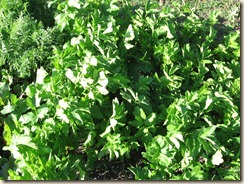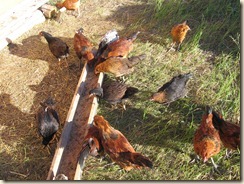Sitting at the table today eating beets, carrots, potatoes, and beans all of which have come from our own garden, mad e me think of how differently we eat now than a few years ago. Can anyone guess what kind of vegetable the plant to the right is? Granted Ramen and Kraft Dinner are the staple of most college students but even after college we often would buy prepackaged, processed food from the grocery store. Not to mention how often we went out to eat for lunch and supper. I suppose we do spend a lot of time collecting and processing our own food but I feel so much better about what we eat it is 100% worth it. Milly and I are both of the opinion that the healthiest way to eat is
e me think of how differently we eat now than a few years ago. Can anyone guess what kind of vegetable the plant to the right is? Granted Ramen and Kraft Dinner are the staple of most college students but even after college we often would buy prepackaged, processed food from the grocery store. Not to mention how often we went out to eat for lunch and supper. I suppose we do spend a lot of time collecting and processing our own food but I feel so much better about what we eat it is 100% worth it. Milly and I are both of the opinion that the healthiest way to eat is from whole food (i.e. carrots, potatoes, eggs) grown by a local source. I don’t care if the farmer is organic certified as long as I can go to the farm and admire, ask questions, and see how things are being grown and produced. We are in the process of raising 20 birds for our own use this winter. I’d like to say we have a ton of connections with local producers but since we moved from Montana we’ have really stepped up the effort in producing our own food. That’s nice if you have the ability but if you don’t have the ability it’s really important to support local producers in your area. It keeps money in your own community and the benefit of eating locally grown food is tremendous. One of our favorite places to visit is a farm in Montana. Mr. and Mrs. Green are even on the Who’s Who list for The Simple Farm. The Green’s send out a newsletter every week updating friends, acquaintances and customers about the happenings on their farm. This last newsletter had an interesting paragraph I’d be interested to hear anyone’s thoughts on. ****************** One of the most enjoyable parts of selling off of our farm is trying to figure out what kind of person buys from us. If we try to categorize them as a type, we are quickly reminded that people don’t fit into slots very well. Maybe I should rephrase that. The people that buy from us normally don’t like to fit into slots. They come from all kinds of backgrounds and occupations, blue collar and professional. Some are older, and some are younger. The common denominator of all of our customers is their concern for the quality and the origin of the food that they eat. Liberal or conservative, rich or not-so-rich, are opting out of the mainstream food system. Documentaries like Food, Inc. and Farmageddon are awakening people to the fact that a thousand cows go into a typical fast food burger, which is formed and cooked in a central location far, far away from the place that it will be re-heated. The customers that patronize us give us more than just money. Some of them are gifted cooks and nutritionists, and the information that they share with us helps us become an even healthier family. Our customers actually do fit into a slot. The category of best. *********************** I think Milly and I fit in the younger, conservative, not so rich category. But it makes me wonder what causes people to turn from the normal grocery store lifestyle to seeking out local farmers and suppliers. When we started looking for local sources of food it was amazing to find quite few people all in the same category as us. That category was we were all looking for good food to eat that was not chalk full of hormones or chemicals. The economic station, up bringing and background, and years on the earth varied greatly but we were all after seemingly illusive good, healthy food. Another thought. Most people think eating locally produced, almost boutique type foods, is more expensive. It certainly does cost more money for semi-comparable products at the local grocery store. A few points on that line of thinking: 1. It’s not comparable food. No way can you compare fresh grown carrots to grocery store cardboard carrots. 2. Overall we spend less money on groceries now than we did in the past. But that mostly is because we rarely buy processed, prepacked, quickie type meals any more. Or go out to eat nearly as often. It just doesn’t tasted as good any more and certainly not worth the price. 3. If you buy “Organic” food from the grocery store the price is pretty hefty. But if you find local food sources the price of food is usually way more reasonable. Especially if you go to the farm directly. It may still cost more than a grocery stores horrible comparison but it’s not nearly as expensive as the grocery stores “Organic” version of good food. This post probably will inflame a few of my favorite readers but hopefully it inspires a few to reach out and contact local producers in your area. I’d love to hear your ideas, comments and experiences on this subject. At what lengths do you go to find good food? I’ll start. I bought a cow and am milking it day and night. I’d also be interested to hear any guesses on the vegetable at the top. Dancing queens says they are rather nice with butter and brown sugar. It would be hard to imagine anything not nice with that combination.
from whole food (i.e. carrots, potatoes, eggs) grown by a local source. I don’t care if the farmer is organic certified as long as I can go to the farm and admire, ask questions, and see how things are being grown and produced. We are in the process of raising 20 birds for our own use this winter. I’d like to say we have a ton of connections with local producers but since we moved from Montana we’ have really stepped up the effort in producing our own food. That’s nice if you have the ability but if you don’t have the ability it’s really important to support local producers in your area. It keeps money in your own community and the benefit of eating locally grown food is tremendous. One of our favorite places to visit is a farm in Montana. Mr. and Mrs. Green are even on the Who’s Who list for The Simple Farm. The Green’s send out a newsletter every week updating friends, acquaintances and customers about the happenings on their farm. This last newsletter had an interesting paragraph I’d be interested to hear anyone’s thoughts on. ****************** One of the most enjoyable parts of selling off of our farm is trying to figure out what kind of person buys from us. If we try to categorize them as a type, we are quickly reminded that people don’t fit into slots very well. Maybe I should rephrase that. The people that buy from us normally don’t like to fit into slots. They come from all kinds of backgrounds and occupations, blue collar and professional. Some are older, and some are younger. The common denominator of all of our customers is their concern for the quality and the origin of the food that they eat. Liberal or conservative, rich or not-so-rich, are opting out of the mainstream food system. Documentaries like Food, Inc. and Farmageddon are awakening people to the fact that a thousand cows go into a typical fast food burger, which is formed and cooked in a central location far, far away from the place that it will be re-heated. The customers that patronize us give us more than just money. Some of them are gifted cooks and nutritionists, and the information that they share with us helps us become an even healthier family. Our customers actually do fit into a slot. The category of best. *********************** I think Milly and I fit in the younger, conservative, not so rich category. But it makes me wonder what causes people to turn from the normal grocery store lifestyle to seeking out local farmers and suppliers. When we started looking for local sources of food it was amazing to find quite few people all in the same category as us. That category was we were all looking for good food to eat that was not chalk full of hormones or chemicals. The economic station, up bringing and background, and years on the earth varied greatly but we were all after seemingly illusive good, healthy food. Another thought. Most people think eating locally produced, almost boutique type foods, is more expensive. It certainly does cost more money for semi-comparable products at the local grocery store. A few points on that line of thinking: 1. It’s not comparable food. No way can you compare fresh grown carrots to grocery store cardboard carrots. 2. Overall we spend less money on groceries now than we did in the past. But that mostly is because we rarely buy processed, prepacked, quickie type meals any more. Or go out to eat nearly as often. It just doesn’t tasted as good any more and certainly not worth the price. 3. If you buy “Organic” food from the grocery store the price is pretty hefty. But if you find local food sources the price of food is usually way more reasonable. Especially if you go to the farm directly. It may still cost more than a grocery stores horrible comparison but it’s not nearly as expensive as the grocery stores “Organic” version of good food. This post probably will inflame a few of my favorite readers but hopefully it inspires a few to reach out and contact local producers in your area. I’d love to hear your ideas, comments and experiences on this subject. At what lengths do you go to find good food? I’ll start. I bought a cow and am milking it day and night. I’d also be interested to hear any guesses on the vegetable at the top. Dancing queens says they are rather nice with butter and brown sugar. It would be hard to imagine anything not nice with that combination.



